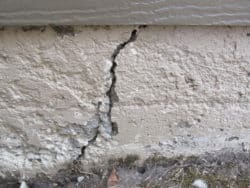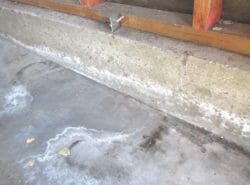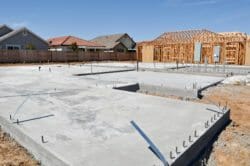Which Basement Wall Cracks Are Structural, Cosmetic or Just Normal?
Home » Structural » Basements »
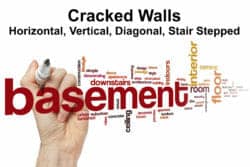
Basement wall cracks
Horizontal, vertical, and diagonal basement wall cracks may be a structural issue, a leaking issue or both, as well as costly to repair. Therefore, it is important to know which ones are major, and which ones are minor.
The seriousness partially depends on factors like the size of the crack, the location, the shape and direction of the crack.
Four basic types of basement walls
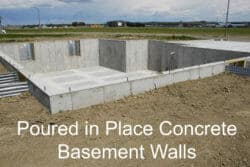
It is not unusual for cracks to appear in basement walls, regardless of the type of wall you have.
Poured in place concrete walls – these are the most common type of basement walls built across the US today. They’re usually constructed by pouring concrete into metal or wood forms and then the forms are removed once the concrete has set-up or hardened.
Masonry block walls – built with rectangular block often called concrete block or cinder block. This type of wall is the second most common wall used for basements today.
Precast concrete walls – are concrete walls built offsite, trucked to the building site, and then set in place.
Brick, stone & clay tile – these types of walls are often found in historic and older homes. Due to the age and construction designs of these walls, they tend to have more cracks and leaks than other walls.
Cracks in masonry block walls often appear at the grout joints which are usually weaker than the block itself. The cracks may be straight, angled or stair stepped.
Of the two most common types of walls, poured in place concrete walls are often considered a little stronger and masonry block walls may be considered more economical to build; however, both types are thought of as good or acceptable walls for basement construction.
Basic causes of basement wall cracks
The majority of basement wall cracks occur because of the following reasons.
- Lateral loads and pressures pushing against the basement wall.
- Foundation movement resulting from soil or other issues.
- Hydrostatic pressures involving wet soils, high water tables and other water issues.
- The “Shrinkage” process of the concrete, especially when first poured.
Shrinkage cracks
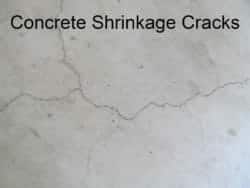
Shrinkage cracks are very common, especially in poured in place concrete walls. They’re a thin, hairline type of crack that does not run all the way though the wall but are very shallow or just on the surface. They normally do not run continuously or in straight lines but tend to meander and have interruptions in a number of places.
When concrete (basically a mixture of sand, aggregate, cement and water) is first mixed together, more water is added then is required for hydration, the chemical curing process, often thought of as the hardening process. This extra water dissipates or evaporates causing stress in the concrete which causes the concrete to shrink. Thus, shrinkage cracks.
Concrete poured when the temperature is cool will have less shrinkage cracks than concrete poured when it is hot; and overall the more water added when first mixed, the more shrinkage cracking there will be. Approximately a 1/3 of the shrinkage cracks occur in the first 10 days, 1/2 in the first month and the majority will occur within a year.
Engineers generally feel that shrinkage cracks are more cosmetic than structural in nature.
Vertical cracks
Vertical cracks in a basement wall may be caused by several common problems.
There are two types of vertical cracks that are generally not considered structural issues. They are:
- Cold joints
- Shrinkage cracks
Cold joints in a basement wall are not structural cracks
Homeowners often think that a cold joint, which at first glance may look like a crack but actually is not. A cold joint is where one batch of concrete is poured and has begun to set up or has hardened and then later another batch of concrete is poured against the previous batch.
The time between the two pours may be several hours, a day, or even weeks or months. Contractors often plan cold joints at specific locations in a concrete wall or slab.
In basement walls cold joints have a propensity to leak unless proper waterproofing has been done
Control joints – Contraction joints
Newer poured in place concrete basements walls may have a straight vertical control joint (sometimes called a contraction joint) running from the bottom of the wall to the top of the wall. These control joints are purposely put there for contraction purposes; so that when the concrete contracts or shrinks, it will crack at that control joint. You might say that they want to control where a crack will appear if it does.
These control joints may appear about every 20 to 30 lineal feet of a perimeter wall and are designed to relive internal stress. Like cold joints, they’re generally not a structural concern but may have a propensity to leak unless proper waterproofing was done
Vertical shrinkage cracks
As a concrete poured in place wall shrinks it develops shrinkage cracks, most of which are small, however, if the concrete mix had too much water in it or if a wall is long wall, you may get a few vertical shrinkage cracks, up to a 1/16 or an 1/8 inch wide. If there are control joints, the cracks may appear in them.
If the footing of basement wall is cracked, shifting or rotating
If the footing of the basement wall is cracked, then there may be a vertical crack in the basement wall near or in line with the crack in the footing. This crack may run partially or all the way from the bottom of the wall to the top of the wall.
If the footing is rotating or tilting, then there may be vertical cracks. If one side of the wall crack is offset from the other side of the crack, then that is more of a concern.
Vertical cracks wider at the top than the bottom
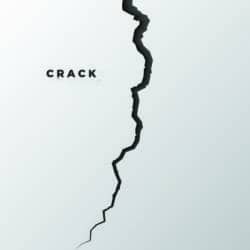
Vertical cracks that are wider at the top than the bottom may be an indication of a cracked footing and differential settling. These types of crack are generally thought to be of a greater concern than some of the other types of vertical cracks. ( Read about differential settling )
If the footing is cracked and one side had shifted downward, then the bottom of the crack is usually smaller than the width of the crack at the top and if the crack is offset, there is even more of a concern.
Excessive force that causes a wall to break away from a corner
Should a stretch of basement wall have more pressure against it than deigned for, it may occasionally cause a crack near the basement corner because the perpendicular wall at the corner provides extra strength to the corner area.
Vertical cracks at a basement wall corner due to water and freezing
Gutter downspouts often dump water at the corners of a house and this may lead to excessive water build-up of the soils at these areas. Should there be vertical cracks near these corners and no horizontal cracking; and there is freezing of this water laden soil, then vertical cracking may occur. ( Read about how freezing water in soil damages foundations and basement walls )
Should this be the case, improving the drainage and the downspout discharge area may help reduce further cracking.
Horizontal cracks
As a general rule horizontal cracks are not caused by settling issues or the footing heaving upward but by issues that create lateral pressure on a basement wall.
Five basic causes of horizontal cracks:
- Back filling soil right after the basement has been poured
- Loading – weight of equipment or vehicles near the basement wall
- Soil loading issues
- Moisture loading and hydrostatic pressure
- Frost heaving and ice lenses
- Rebar issues
Back-fill issues
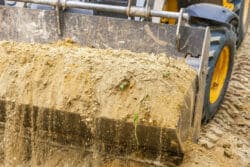
When building a new house, contractors are usually on a tight time schedule and occasionally they get in too big of a hurry. A good example of this is when a contractor backfills the gap between a new basement wall and the edge of the hole dug for the basement before the wall is strong enough to handle the weight of the soil against it.
A concrete basement wall generally does not gain its full structural strength for about 28 days. If a contractor backfills soil against the wall too soon, the pressure of the soil pushing against the wall creates lateral stress, resulting in cracks. These cracks are more likely be to be horizontal than vertical.
Compaction too soon or too forceful
When back filling the space next to a basement wall it is important to get good compaction. Several of the problems with poor compaction is that loose compaction fill holds more water than well compacted soil. This adds to the hydrostatic pressure against basement walls and causes more damage when the soil freezes or develops ice lenses.
Loading at the top area of the wall
Where there is a driveway or parking area next to or near a homes foundation there may be a loading issue that results in the basement walls developing horizontal cracks. The weight of vehicles or heavy equipment sitting or driving near a foundation puts downward pressure on the soil which then adds to the existing lateral pressure against the basement wall in that area. This extra pressure, depending on the amount of it may lead to horizontal cracks.
These cracks will normally occur in the top 1/3 area of the basement wall.
Horizontal cracks due to soil and water issue
Soil loading

The weight of soil pressing against a basement wall may cause horizontal cracking at times. Evidence of this being an issue would be that the wall is bowed or tilting inwardly. In the case of soil loading, the greatest pressure on a wall is generally in the bottom third area of the wall.
Should the home be on a hillside, the uphill side will frequently have more lateral pressure than the downhill side.
Hydrostatic pressure / Water loading
Soil heavily laden with water may exert significant pressure on a basement wall. Not only is hydrostatic pressure one of the main causes for a basement to leak, but it is one of the key factors in crating lateral pressure. High water tables and poor drainage are two of the main culprits; also, sewer and water line leaks may likewise contribute or cause hydrostatic pressure.
Expansive soils
Homes that have clayey types of soils against their basement wall will often experience significant cracking when the soil gets wet; for these soils expand in volume when they are wet and place tremendous lateral pressures on a basement wall. ( Read about expansive soils and what you can do to decrease damage from them )
Look for efflorescence – it’s an indication of moisture on the exterior side of the wall
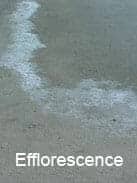
At times if you see a white powdery or sugary looking substance on a wall, it may be an indication that the there is a moisture issue. This white material is called efflorescence and will often brush off or fall off if you rub your hand across it. Normally it will be just a thin layer but in severe cases may be an 1/8 of an inch or thicker. ( Read more about efflorescence problems )
Remember – if a wall bows from pressure exerted on the outside portion of the wall and then the pressure is removed or stops, the wall will normally stay bowed, because as the wall moves inward, soil fills this area which keeps the bow inward; thus, the wall does not shift outwardly to straighten back up when the pressure is relieved.
Horizontal cracks due to Frost Heaving and Ice Lenses

Much of the United States has climate conditions where the soils next to a basement wall will experience freezing: at times this soil may freeze and thaw several times in a year. Soils that are wet or saturated with water will expand significantly when they freeze.
This freezing process exerts tremendous pressures on basement walls, so much that they may crack, tilt or bow and generally when they crack, it will be a horizontal crack. In a few instances there may be vertical cracks, and if so, they tend to be in the corner areas of a basement. (Read more about how and why freezing soil damages basements and foundations )
Block wall horizontal cracks
Horizontal cracks in a block (masonry) basement wall are caused by many of the same issues and forces as those of a poured in place concrete wall.
When looking at a block wall there are several of things to watch for, including horizontal cracks in the mid 1/3 area and also horizontal cracks near the bottom course of blocks. In the mid-section, check for cracks that have opened up an 1/8 inch or more and if the wall has bowed in this mid-section. If the wall has bowed out 3/8 of an inch or more, a number of engineers would suggest further investigation.
Another area of concern may be a crack at the gout line above the first few bottom courses of the block wall or if the bottom course of blocks appears to have shifted; if the concrete floor has a parallel crack to the horizontal cracks in the wall, then there are additional concerns.
Diagonal and stair stepped cracks
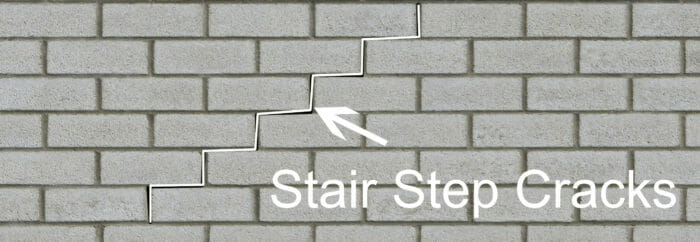
Diagonal cracks in a poured in place wall may be more related to shifting soils, settlement, expansive soils or even footing compaction issues.
A diagonal crack running from the top of a poured in place wall that runs down to the bottom of a wall corner may be from lateral pressure against the top and / or midway section of the wall, especially if there is evidence that the wall tilts inwardly at the top area near the top area of the crack. Also, the wall may have a damaged first floor sill plate or the exterior framed house wall may be offset (not squarely sitting on the top of the foundation wall.
Another scenario could be that the basement wall was backfilled before the first floor of the house was framed, which helps prevent an inward or tilting movement of the basement wall causing a diagonal crack.
Excessive lateral loads accompanied by differential settlement may likewise lead to diagonal cracking.
Cracks at basement window and door corners
Shrinkage issues are one the primary causes of cracks at window and door corners, especially in poured in place concrete walls. A second cause of cracks at door and window corners is stress, for there can be considerable stress that may be concentrated at these areas.
The stress on these corner areas will often develop when there’s a shifting or movement of the footings and / or basement walls. Very small cracks at these areas will generally not be of a major concern to many engineers, however, wide cracks increase an engineer’s concerns.
Small chunks of concrete falling off wall

Should there be small chunks of concrete falling off a basement wall there may be a problem with the steel rebar in the wall or with anchor bolts embedded in the wall at the top of the wall. Over time rusting rebar will deteriorate the structural strength of a wall, but moisture penetrating the wall is normally what creates the problem in the beginning.
Concrete contractors often refer this breaking off of concrete chunks as spalling.
Earthquakes, floods and geotechnical events
When basement walls are exposed to earthquakes or flooding, they may move or crack. Structurally, they can only withstand so much pressure from these types of events. If buying a home that has experienced unusual movement or flooding, it is wise to look more carefully for damage. ( Read what to look for if a home has experienced a flood )
Homes that are in an area with slope creep or expansive soils may warrant extra attention if cracks start appearing or the top of the basement wall is not level. ( Read about slope creep )
Structural Engineers
It can be difficult and confusing when analyzing what is causing cracks, leaks and damage to a basement wall because there are so many different conditions, variables and circumstances that affect a wall. Therefore, consulting with a qualified structural engineer would help in understanding about existing cracks and what is taking place with the home.
Key homeowner tip on prevention and reduction of wall cracking
Many of the common issues when it comes to basement wall cracks and leaks are moisture issues. Poor and improper drainage is probably the most important thing that most homeowners can deal with. The less moisture near the foundation and basement wall, the better.
Following are a few ideas that homeowners may want to check or improve.
- Check to see if the soil slopes away from the home. A basic rule is that the soil slopes away from the home and drops 6 inches in 10 feet; further is better. There should not be any areas where water will stand or puddle.
- Do all patios, walks and drives drain away from the house, not toward it? Be sure water is channeled away from the house.
- Roof. Where does the water go from the roof when it rains or the snow melts on the roof? Are there gutters and are they in good repair: is the size of the gutter large enough to carry the water off? Are the gutters clean?
- Down spouts. Downspouts should be connected to drain piping that will carry the water a good distance from the basement wall. Preferably to the street. No water should be discharged next to or near the foundation.
- Check yard and planter sprinkler systems. Avoid over watering and repair any leaking pipes. Do any planters trap water?
The less moisture and the further away moisture sources are from basement walls, the better.

1. It is not uncommon for basements walls to have cracks and in general, the older the home, the more likelihood of cracks. Many cracks are small, and some are even normal; i.e. shrinkage cracks.
2. Just looking at a crack without looking at the big picture makes it hard to fully understand the seriousness of a crack or cracks. Therefore, keep in mind that you should step back at look at the entire home as well.
3. Since many wall and crack issues relate to moisture and drainage, it would be wise to review how good the drainage is at your home or if it needs improving.
